
Cauterizing Tools Page Menu: 1 2 3 4 5 6 <<First
Cauterizing Tools of the Golden Age of Piracy, Page 6
Actual Cautery Protective Devices
Although cauterizing seems barbaric to us today, it was considered the best way to treat certain problems during this time.
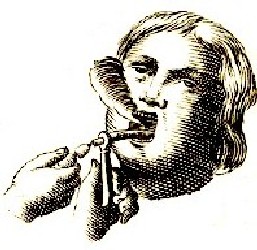
Cauterizing the Mouth Using a Pipe,
From
L'Arcenal de Chirurgie by
Jacques
Guillemeau,
p. 152 (1597)
So it was viewed as a necessary evil by many of the golden age surgeons. They were still very concerned about doing unnecessary damage to the body, however. Guillemeau tells surgeons that when using cauteries, they should be "consideringe, & taking heede, that in noe sorte you chaunce to hurte the circumjacent, or finitimate [neighboring] parte thereunto"1.
As a result, surgeons attempted to protect the 'sound' or healthy skin using various methods. Guillemeau tells us that for the prevention of accidental burning, "ther are invented, & founde out divers defensions [defenses], for the foresayed Cautery, as certain pipes, & little cases being composed, and made of Iron, least that we shoulde chau[n]ce to combute [burn], the finitimate [nearby], & approximate partes, whether it weare thoughe the faulte of the patient, or els throughe temerousnes [rashness], & timorousness of the Chyrurgian"2. There were several different ways to protect the skin. These included: cannulas or pipes that keep cautery irons from directly touching surrounding skin, depth restrictors which prevent the cautery from burning too deep, and metal shields with holes in them to keep the iron from burning outside the intended area.
1,2 Jacques Guillemeau, The French Chirurgerie, p. 41
Actual Cautery Protective Devices - Canulas (Pipes)
A common way to protect skin was by using pipes to guide the cautery irons to the spot where they were needed without directly touching the surrounding skin. Many period surgical authors mention canulas (Latin for 'little reed') in conjunction with the use of the irons.
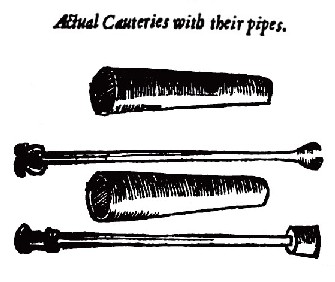
Actual Cauteries with their pipes - From Ambroise Paré's The
Workes of that Famous Chirurgion Ambrose Parey, p. 487 (1649)
Modern author John Kirkup explains:
Plain iron tubes with terminal or lateral apertures were used from at least medieval times until the eighteenth century to convey hot iron cauteries safely into the mouth, rectum and other cavities in order to avoid burning healthy tissues.1
Hippocrates himself recommended them for treating hemorrhoids with "the tube being introduced into the anus, [after which] the iron, red hot, is to be passed down it, and frequently drawn out, so that the part may bear the more heat, and no sore may result from the heating"2. Note that Hippocrates specifies that the iron be removed from the pipe repeatedly to avoid heating the metal pipe and defeating it's purpose.
French surgeon Ambroise Paré explained that "in rotten bones that lie deep in ...you cannot make use of the formerly described [cautery irons], without your touching of the neighboring sound parts. To avoid which danger, you shall put your Cauterie even to the bone through an iron pipe, which may keep the neighboring and fleshie parts from burning."3 The figure that appears above right shows this. Note the tapering on the pipes, presumably to direct the iron tip and allow air space around the iron to avoid heating the pipe when the cautery iron is inserted.
English military surgeon Richard Wiseman likewise recommended the cannula as a way to cauterize the bone at the bottom of an ulcer. He explained that this "Cannula or Pipe ought to be covered with an Emplaster or Linen starched on, and oiled, to pass in more easily. Then having a Bason of Water ready to cool the Pipe, you shall place the Cannula upon the carious Bone, having first cleansed the Matter from it with armed Probes: then pass the actual Cautery down through the Cannula to the Bone so often till you have dried it, pulling out the Cannula after each heat. So you may perform the work without scorching the Lips of the Ulcer."4 German surgeon Matthias Gottfried Purmann mentions this method as well, explaining that cauteries could be used "with or without a Pipe, which are commonly practiced where there are rotten Bones"5.
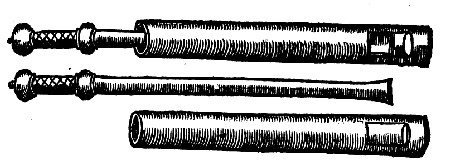
Cautery Iron with Pipe or Eating Ulcers- From Ambroise Paré's The
Workes of that Famous Chirurgion Ambrose Parey, p. 232 (1649)
Paré describes another cautery iron/pipe combination for treatment when "an eating ulcer shall associate this relaxation of the Uvula [????]; together with a flux of blood." He explains that it "must be burnt and seared with a hot iron, so thrust into a Trunk, or Pipe with a hole in it, that so no sound part of the mouth may be offended therewith."6 This cautery can be seen at left. Notice that the pipe is not tapered.
Jacques Guillemeau provided a very detailed description of a type of cautery/cannula arrangement, which can be seen below. He advised the surgeon to use a "canole, or pype, which is verye necessary, to conducte the Cauterye into the mouth, when we desire to cauterize the pallate of the mouthe, or any other parte."7 The window in the pipe, which was to be placed at the location the surgeon wanted to cauterize.
Guillemeau spends quite a bit of time discussing the ring on the side of the cannula "by the which we houlde the same... [so that] the Chirurgiane chauncede not to burne his fingers, in executinge his operatione, by the which his worcke might be interruptede."8 He even calls attention to the "hole of the ring, through the which we may thruste our finger, to houlde faste the foresayede canulle."9 It is an interesting feature, given that Paré's cannulas, intended for the same purpose, do not have them.
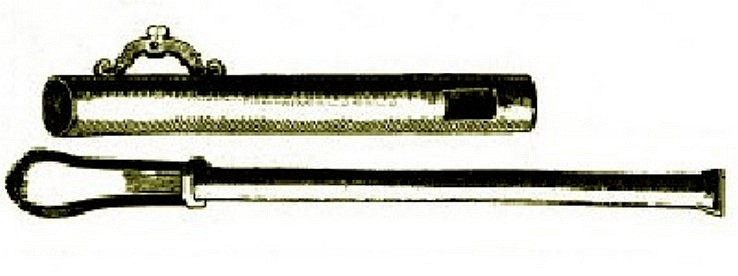 Bolt Style Cautery Iron and Cannula - From Jacques Guillemeau's The French Chirurgerie, p. 23 (1597) |
Wiseman also suggested the use of a canula to treat a fistula in ano [fistula which opens into the anus]. He advised using "an actual Cautery of the fashion of a bolt, with a Cannula having a hole cut in it to receive the great Excrescence near the Sphincter... [see the image above for an example] The Cautery being ready, and a bason of Water with Sponges to cool it [he appears to be referring to cooling the canula here]; the Patient rose out of his Bed, and placed himself towards the light, leaning upon the side of his Bed without any body to hold him. I anointed the Cannula upon the Excrescence; then passed in an actual Cautery glowing hot, and repeated the use of it so often, till the ...callous Lips [were] consumed"10.
1 John Kirkup, The Evolution of Surgical Instruments; An Illustrated History from Ancient Time to the Twentieth Century, p. 407; 2 Hippocrates, On Hemorrhoids, p. 140; 3 Ambroise Paré, The Workes of that Famous Chirurgion Ambrose Parey, p. 487; 4 Richard Wiseman, Eight Chirurgicall Treatises, 3rd Edition, p. 183; 5 Matthias Gottfried Purmann, Churgia Curiosa, p. 209; 6 Paré, p. 231; 7,8,9 Jacques Guillemeau, The French Chirurgerie, p. 23; 10 Wiseman, p. 237
Actual Cautery Protective Devices - Depth Restrictors
There was some concern about not burning too deeply when cauterizing. In support of preventing a cautery from going too far into the body during the operation, Jacques Guillemeau shows two different methods.
The first depth restricting cautery iron uses a series of holes in the tip of the cautery iron combined with a little pin that fits in them. The iron depth is then restricted by the perpendicular pin from entering a wound being cauterized. Guillemeau calls this "the Empique Cauterye, vereye necessarey to open the ulcerations, or Apostemations of the fleshe, callede Empiernata [Empyema]."1 He explains that holes in the end of the iron are there to allow the surgeon to "thruste [in] an Iron pegge, to penetrate, as deepe, & as shallo we as we please."2 This is a simple arrangement, although because the pin would have been put in place before heating, it would be red hot when the iron was thrust into the ulcer, potentially burning the skin as well.
 Depth Restricting Cautery Iron with Cross Pin - From Jacques Guillemeau's The French Chirurgerie, p. 23 (1597) |
Ambroise Paré shows a nearly identical cautery with pin arrangement for treating a pleurisy which has turned into an empyema in the chest.

Pegged Cautery Iron Described in Paré - From Helkiah Crooke's An explanation of
the fashion and use of three and fifty instruments of chirurgery, p. 6 (1634)
Here, as Paré explains it, the surgeon "beginning to reckon from below upwards, may make a vent between the third and fourth true and legitimate ribs"3. He details the use of the cautery iron, showing the figure seen at right and explaining that "it is perforated with four holes, through one whereof there is a pin put higher or lower according to the depth and manner of your incision"4.
The second type of depth restricting cautery is much simpler in design and does not have the problem of the red hot cross bar. Guillemeau notes that this iron "is vereye necessary to ope[n] the Ulceratio[n] Ranula [a swelling in the floor of the mouth] which is situated under the tung."5 Here the idea is that the little round part of near the end of the iron is bigger than the rectangular hole in the plate. Guillemeau explains that the plate lays "in the mouth, because we shoulde nether burne the tonge, nor the mouthe"6, so it serves two purposes. Looking at the size of the iron, one can't help but wonder how the surgeon decided what depth was appropriate.
 Depth Restricting Cautery Iron with Plate - From Jacques Guillemeau's The French Chirurgerie, p. 23 (1597) |
1,2 Jacques Guillemeau, The French Chirurgerie, p. 23; 3,4 Ambroise Paré, The Workes of that Famous Chirurgion Ambrose Parey, p. 234; 5,6 Guillemeau, ibid
Actual Cautery Protective Devices - Plates and Depth Restricting Cautery Irons
"To use the Cautery aright, there should be a flat Iron Plate to preserve the adjacent Parts, with a Hole thro’ the Middle, made fit to receive the End of the heated Button on the Artery. Hoc modo tutius est; atque minus vicina partes lædit. [Roughly, 'In this way, it is safer to the neighboring parts and protects them.]" (John Atkins, The Navy Surgeon, p. 122)
The method for protecting the skins which is most wide supported in the period texts under study is through the use of metal plates with holes (often figured as being square or rectangular) in the middle of them. Surgeons mention such plates repeatedly in two particular operations: the ranula and the empyema.

Photo: Wiki User Ph0t0Happy - A Ranula
A ranula is a translucent blue, dome-shaped swelling in the floor of the mouth while an empyema is a buildup of pus, often in the space between the lung and the inner surface of the chest wall.
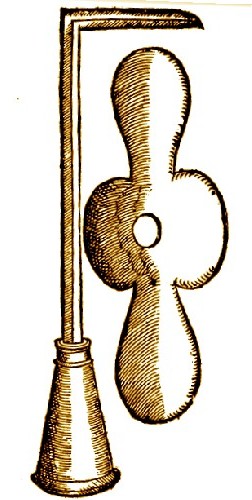
Cautery Iron & Shield for Ranulas - From
Helkiah
Crooke's An explanation of the fashion
and use
of three and fifty instruments
of chirurgery, p. 6 (1634)
Jacques Guillemeau's second depth restricted cautery iron in the previous section was to be used for ranulas. The design of the shield shown previously is shaped a bit like a flower. Another rendering of such a plate can be seen again in the image (from Helkiah Crooke's book) at right. Note that plate features a round hole.) Given the space that it was to work in, it must have been about 3" across at the narrow part (which was to go in the mouth) and about 6 to 8 inches from top to bottom (which was what the surgeon's assistants used to hold the plate once it was in place).
Military surgeon Richard Wiseman describes such a plate as "a Tin-instrument [placed] between the Tongue and the Excrescence which was rooted on the Ranula, of the shape of a Crista [crest], thick and hard, bearing the Tip of the Tongue backward."2 He could then insert a bolt-shaped cautery into the aperture to burn the swelling. Based on its purpose and these drawings, this type of plate was probably about six inches long and 3 inches across.
Helkiah Crooke also describes treating the "tumor which is called Ranula: (it is under the tongue, and corrupts the speech.)"3 He details that the surgeon "frames a plate of Iron, such as you see hollowed on the inside; and with a hole in the middlest. The mouth is held wide open, and the plate applyed to the Tumor, so that the hole therein may fall just upon that part of the Tumor, which you would open then with a red hot crooked iron like this in the figure, pierce the Tumor, and therewithal with your thumb under the roote of the Chin, beare up the Tumor with some force and strength, that you may pierce it the deeper, &c."4
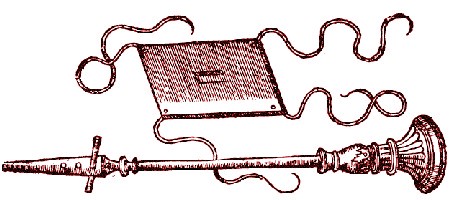
Pegged Cautery Iron Described in Paré - From Helkiah Crooke's An explanation of
the fashion and use of three and fifty instruments of chirurgery, p. 6 (1634)
Although Guillemeau only describes a pegged cautery for use on an empyema, Ambroise Paré combines that with a shield, explaining that the point of the iron "is thrust through a plate of Iron perorated also in the midst, into the part designed [indicated] by the Physition, lest the wavering hand might peradventure touch, and so hurt the other parts not to be medled withall."5 He sketches this shield with the iron as seen at left. This is a better design than Guillemeau's because the surgeon wouldn't have to worry about the red hot cross pin touching the skins and leaving unnecessary burns on the skin.
Crooke, drawing upon Paré's work, suggesting that the cautery and plate be used "in Empyemate [Empyema], that is, when upon a squinzie [an acute inflammation of the soft palate around the tonsils] or pleurisie [inflammation of the lining of the chest cavity] or other ways sometimes, [where] there is a notable

Cautery Iron Shield with Round Hole - From Jacques Guillemeau's
The French Chirurgerie, p. 18 (1597)
collection of purulent matter in the capacity of the Chest."6 He explains the design of protective plate more fully.
...the Chirurgion shall place (upon the side the Physitian shall designe [indicate]) an Iron plate with a hole in the middest, fit for the Cautery to enter into. That plate having strings at the foure corners, must be tyed on the other side of the Patients body, so fast that it may comply with the fashion of the ribbes.7
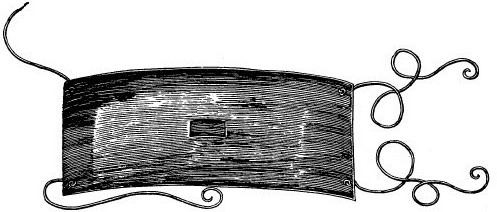
Cautery Shield - From Jacques Guillemeau's
The French Chirurgerie, p. 16 (1597)
Guillemeau describes another, more generic protective plate. He also draws attention to the "little ribbons, which are necessarye to tye the plate one the Arme, Hippe, or anye other parte of the bodye, whe[n] we would cauterize the same, leaste that in the operatione it should glide away."8 The interesting point in Guillemeau's text is that he recommends the plate for many different types of operations, not just the ranula and empyema. Even so, where there are large wounds with custom-shaped cautery irons, making a plate specific to each type would seem to be very inefficient.
1 See Jacques Guillemeau, The French Chirurgerie, p. 23, quoted in footnote 4 the previous section; 2 Richard Wiseman, Eight Chirurgicall Treatises, 3rd Edition, p. 237; 3,4 Helkiah Crooke, An explanation of the fashion and use of three and fifty instruments of chirurgery, p. 5-6; 5 Ambroise Paré, The
Workes of that Famous Chirurgion Ambrose Parey, p. 234; 6 Crooke, page 6; 7 Crooke, page 6-7; 8 Guillemeau, ibid.

